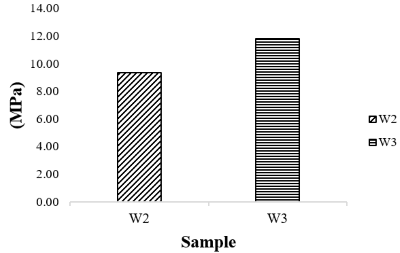The Effect of Compressive Strength Paving Blocks Utilizing Polypropylene Plastic Waste
DOI:
https://doi.org/10.24036/cived.v11i3.662Keywords:
Polypropylene, Paving Block, Waste, Compressive StrengthAbstract
Waste is a big problem for every country in the world, including cities. Currently, the city of Balikpapan is experiencing rapid economic and population growth, of course the growth also brings challenge in waste management, especially plastic waste. The type of plastic waste than we often encounter especially in coffe shops is Polypropylene (PP). In this research, pp type plastic waste is recycled as a substitute for cement in paving blocks with a composition of 30%, 40%, 50% to sand. The test conducted on this research is compressive strength. The purpose of this research is to determine the effect of PP plastic melt mixture on paving block mortar on increasing compressive strength. From the research results obtained the maximum compressive strength value for the composition of 50% Polypropylene : 50% sand with a compressive strength value of 11,83 Mpa. Similiarly, with the composotion of 40% Polypropylene : 40% sand, this value of is included in the quality D which can be used for parks according to SNI 03-0691-1996. While the 30% composition is not included in the quality.
Downloads
References
A. Kurniyawan and A. M. Putri, “INOVASI PENGELOLAAN SAMPAH KOTA BALIKPAPAN SEBAGAI PINTU GERBANG IBU KOTA NUSANTARA (IKN),” Samarinda, 2023.
D. Indah Damayanti, A. Marini Indriani, and G. Utomo, “Influence Utilization Waste Plastic Polyethylene Terephthalate on the Flexural Strength of Concrete with Use East Kalimantan Aggregate,” 2023. [Online]. Available: http://cived.ppj.unp.ac.id/index.php/CIVED766
Achidah, M. A. Indriani, and G. Utomo, “Pengaruh Penambahan Cacahan Plastik PET (Polyethylene Terephthalate) Pada Beton Menggunakan Agregat Kasar Batu Petangis Terhadap Kuat Tekan ,” 2024.
H. Kapita, M. Aswan, and D. T. C. Aswan, “Pengujian Kuat Tekan Beton Pada Paving Block Berbahan Baku Limbah Plastik,” Jurnal Serambi Engineering, vol. 8, no. 2, 2023, doi: 10.32672/jse.v8i2.5966.
R. Mildawati, H. Dewi, and F. Syefringga, “Pengaruh Penambahan Limbah Plastik Sebagai Campuran Beton Terhadap Kuat Tekan dan Daya Serap Air Pada Paving Block,” Jurnal Teknik Sipil Unaya, vol. 8, 2022.
Badan Standarisasi Nasional, “SNI 03-0691-1996,” 1996.
S. N. Hijah, M. Hamsyuni, D. Basoeki, and I. Iskandar, “Pengaruh Campuran Limbah Anorganik (Plastik) Sebagai Pengganti Semen Terhadap Kuat Tekan Paving Block,” 2022.
F. Patriotika, S. S. Pulungan, and ..., “Uji Kesesuaian Kuat Tekan Paving Block Menggunakan Bahan Dasar Sampah Plastik PET dan LDPE dengan SNI 03-0691-1996,” Borneo Engineering: Jurnal …, vol. 6, no. 3, 2022.
T. W. Widianto, A. M. Indriani, and G. Utomo, “Kuat Lentur Beton Menggunakan Agregat Batu Petangis dan Pasir Semboja dengan Penambahan Botol Plastik,” Jurnal Manajemen Teknologi & Teknik Sipil, vol. 6, no. 2, pp. 112–122, Dec. 2023, doi: 10.30737/jurmateks.v6i2.4989.
B. Indrawijaya et al., “PEMANFAATAN LIMBAH PLASTIK LDPE SEBAGAI PENGGANTI AGREGAT UNTUK PEMBUATAN PAVING BLOK BETON,” 2019.
D. A. Azzaki, D. R. Jati, A. Sulastri, R. Irsan, and J. Jumiati, “Analisis Pemanfaatan Sampah Plastik dengan Metode Buang, Pisah, dan Untung Menggunakan Sistem Barcode,” Jurnal Ilmu Lingkungan, vol. 20, no. 2, 2022, doi: 10.14710/jil.20.2.252-262.
V. Selyn, M. W. Rifki, and M. Ulfah, “Pemanfaatan Limbah Plastik Poly Propylene (PP) Dalam Pembuatan Paving Blok,” Jurnal Fakultas Teknik Industri, Universitas Bung Hatta, vol. 18, no. 4, 2021.
Yazid, Husaini, and Gefry, “PENGGUNAAN LIMBAH PLASTIK POLYPROPYLENE SEBAGAI SUBSTITUSI SEMEN PADA PAVING BLOCK,” Jurnal Teknologi dan Rekayasa Sipil, vol. 1, pp. 34–38, 2023.
A. G. Kusuma, “Pemanfaatan Sampah Plastik Jenis PP (Poly Propylene) sebagai Substitusi Agregat pada Bata Beton (Paving Block) Utilization of Poly Propylene Plastic Chopped as Aggregate Substitution on Paving Block,” 2019.
A. Aprilianti, “PEMANFAATAN SAMPAH PLASTIK JENIS PP (POLYPROPYLENE) SEBAGAI SUBSTITUSI AGREGAT HALUS PADA PAVING BLOCK,” 2019.
Rajab Niar, Sahara, and Wahyuni Ayusari, “PENGARUH PENAMBAHAN LIMBAH PLASTIK JENIS POLYETHYLENE TEREPHTHALATE, LOW DENSITY POLYETHYLENE DAN POLYPROPYLENE TERHADAP NILAI KUAT TEKAN DAN DAYA SERAP AIR PAVING BLOCK,” JURNAL FISIKA DAN TERAPAN, vol. X (Nomor), p. halaman-halaman, 2021, [Online]. Available: http://journal.uin-alauddin.ac.id/index.php/jft
I. Cahyani, D. Irfaniyah, F. Alfarizki, and H. Kusumah, “Paving Block Quality With Several Types of Plastic Waste on Compressive Strength,” Jurnal Ilmiah Multidisipline, vol. 1, pp. 110–116, 2023, doi: 10.5281/zenodo.10428700.

Downloads
Published
Issue
Section
License
Copyright (c) 2024 Vanessa Regina Vetryx, Andi Marini Indriani, Gunaedy Utomo

This work is licensed under a Creative Commons Attribution 4.0 International License.

